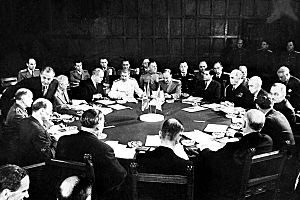Potsdam Declaration facts for kids
The Potsdam Declaration was a very important statement made during World War II. It was also called the Proclamation Defining Terms for Japanese Surrender. This document asked Japan to surrender all its armed forces.
It was issued on July 26, 1945. Three major leaders signed it: Harry S. Truman, who was the President of the United States; Winston Churchill, the Prime Minister of the United Kingdom; and Chiang Kai-shek, the leader of China. The declaration explained the conditions for Japan's surrender. These conditions were first discussed at the Potsdam Conference.
The declaration warned Japan that if it did not surrender, it would face "prompt and utter destruction."
Contents
What Was the Potsdam Declaration?
The Potsdam Declaration was a special message sent to Japan during the final days of World War II. It was a clear demand for Japan to stop fighting. The leaders of the Allied powers wanted to end the war quickly and save lives.
This declaration laid out what would happen if Japan surrendered. It also warned about the serious consequences if Japan chose to continue the war.
Who Issued the Declaration?
The Potsdam Declaration was issued by three powerful leaders of the Allied forces. These were the countries fighting against Japan in World War II.
Leaders Who Signed
- Harry S. Truman: He was the President of the United States. He had just taken office after President Roosevelt passed away.
- Winston Churchill: He was the Prime Minister of the United Kingdom. He was a very famous leader during the war.
- Chiang Kai-shek: He was the Chairman of the Republic of China. China had been fighting Japan for many years.
These leaders met at the Potsdam Conference in Germany. They discussed how to end the war with Japan.
What Did the Declaration Demand?
The Potsdam Declaration had several key demands for Japan. These demands were meant to ensure a complete and peaceful end to the war.
Key Terms for Surrender
- Unconditional Surrender: Japan's armed forces had to surrender completely. This meant they could not set any conditions for their surrender.
- Removal of Militarism: The declaration demanded that Japan's military leaders and those who pushed for war be removed from power.
- Occupation of Japan: Allied forces would temporarily occupy parts of Japan. This was to make sure Japan followed the surrender terms.
- Return of Territories: Japan had to give up all the territories it had taken by force. This included places like Korea and parts of China.
- Democratic Government: The declaration suggested that Japan should form a new, peaceful, and democratic government. This government would respect human rights.
Why Was the Declaration Important?
The Potsdam Declaration was a final warning to Japan. It showed that the Allied powers were united and determined to end the war.
The Warning of "Utter Destruction"
The declaration's most famous line warned of "prompt and utter destruction" if Japan did not surrender. This warning was very serious. It came just before the atomic bombs were used. The bombs were dropped on Hiroshima and Nagasaki shortly after Japan did not accept the declaration.
The Potsdam Declaration played a big role in the final days of World War II. It set the stage for Japan's surrender and the end of the war.
See also
 In Spanish: Declaración de Potsdam para niños
In Spanish: Declaración de Potsdam para niños


